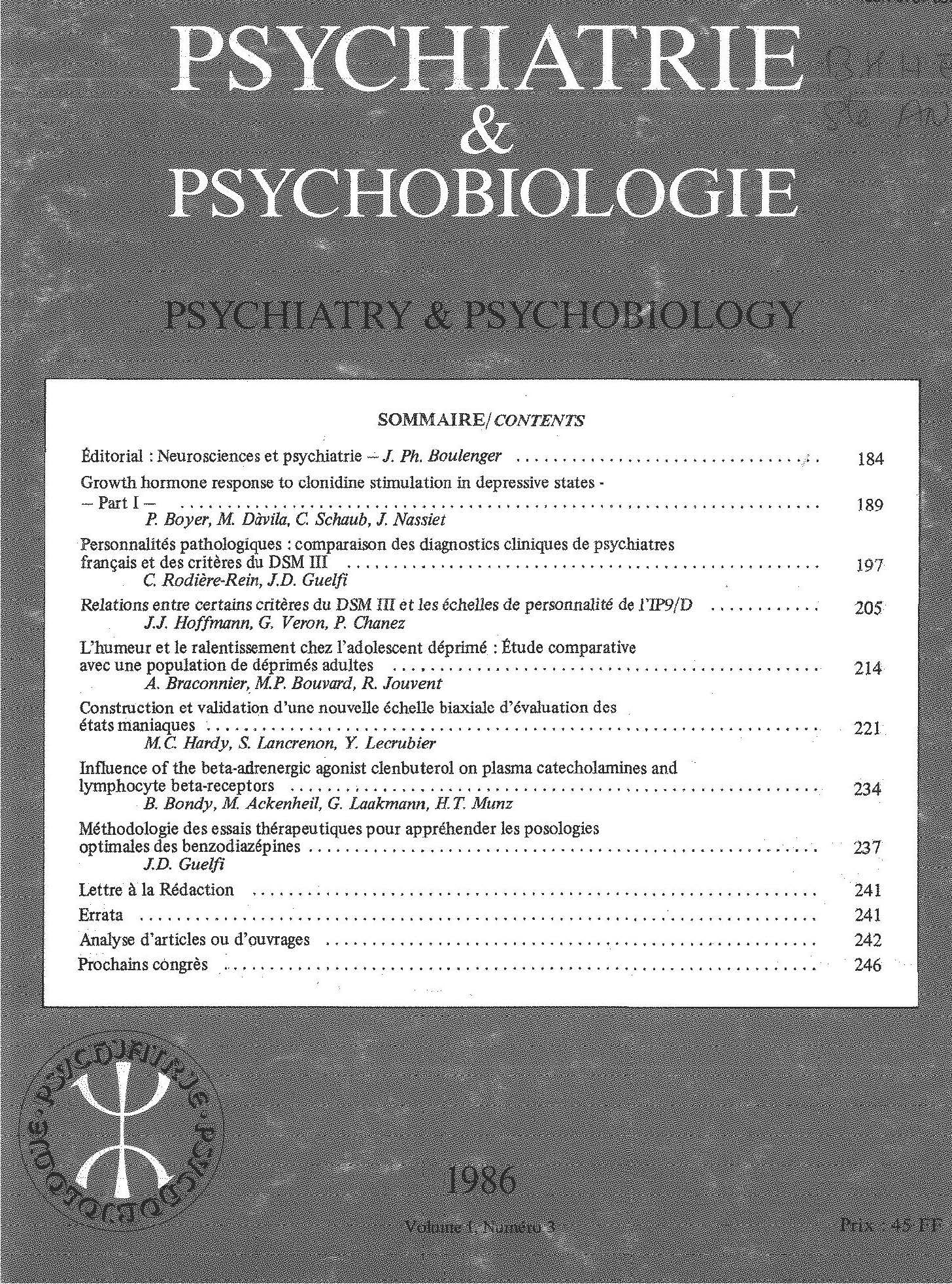Article contents
Inventaires d'auto-évaluation de la psychopathologie chez l'adulte. 1re partie: inventaires multidimensionnels
Published online by Cambridge University Press: 28 April 2020
Résumé
Les inventaires d'auto-évaluation de la psychopathologie chez l'adulte ont connu un développement remarquable au cours des 2 dernières décennies, à la fois en recherche clinique et en épidémiologie; leurs avantages et leurs limitations sont considérés dans cette revue. Leur construction, leur adaptation éventuelle, l'évaluation de leurs qualités métrologiques et l'établissement de leur stabilité factorielle reposent sur des concepts mélhodologiques dont l'origine et les définitions sont brièvement rappelées. Les Hopkins Symptom Check-Lists (HSCL) et le General Health Questionnaire (GHQ) représentent actuellement les 2 grandes familles d'inventaires multidimensionnels. Parmi les différentes HSCL, la HSCL-58 est l'inventaire le plus couramment utilisé, notamment en psychopharmacologie, grâce à sa diffusion, à sa facilité d'emploi, à sa bonne validité externe et à sa structure factorielle si on se limite aux troubles anxiodépressifs non psychotiques. L'existence des 9 dimensions symptomatiques primaires de la SCL-90 est beaucoup moins bien établie, mais ce questionnaire a été utilisé pour des enquêtes épidémiologiques et des essais cliniques, globalement ou à travers certaines de ses dimensions. Plusieurs versions et plusieurs cotations du GHQ ont été produites à partir des 60 items initiaux (GHQ-30, 28, 20, 12). Ils ont fait l'objet de nombreuses études de validation, qui ont, dans l'ensemble, confirmé son intérêt. Le GHQ-28, le plus récent, produit d'analyses factorielles du GHQ-60, englobe 4 dimensions de 7 items chacune: anxiété et insomnie, dépression sévère, gêne sociale, plaintes somatiques. A partir de plusieurs exemples internationaux, le GHQ s'est avéré être un outil intéressant pour le dépistage des cas psychiatriques. En conséquence, la version française du GHQ-28 nous paraît devoir être largement diffusée.
Summary
Self-report symptom inventories for adults have undergone significant development over the last twenty years, both as regards clinical research and epidemiology. In this review, their advantages and shortcomings are considered. The composition and adaptation of questionnaires, the assessment of their metrological qualities, and their putative factor structure are based on concepts whose origin and definition have been briefly noted. The Hopkins Symptom Check-Lists (HSCL) and the General Health Questionnaire (GHQ) currently constitute the two main types of multi-dimensional inventories. The most widely used of the HSCLs is the 58-item version (HSCL-58), especially in psychopharmacology, due to its widespread distribution, external validity, ease of administration and factorial structure as far as non-psychotic anxious-depressive patients are concerned. Regarding the SCL-90R, however the existence of nine postulated symptomatic dimensions is less well established; but eitlter in its entirely or through some of its dimensions it has been used in epidemiologic community surveys and clinical trials. Several versions and scorings of the GHQ have been provided from the original 60 items (GHQ-30, 28, 20, 12). They have resulted in many validation studies, which on the whole have confirmed its value. The most recent version, the GHQ-28, was constructed from factor analyses of the 60-item version and encompasses four dimensions, with seven items in each: anxiety and insomnia, severe depression, social dysfunction, Somatic symptoms. Through several international studies, the GHQ has proved to be an interesting tool for the screening of psychiatric cases in the community and in general practice. As a result we consider that the French version of the GHQ-28 should be made widely available.
Keywords
- Type
- Article original
- Information
- Copyright
- Copyright © European Psychiatric Association 1990
References
Références
A correction has been issued for this article:
- 51
- Cited by
Linked content
Please note a has been issued for this article.



Comments
No Comments have been published for this article.